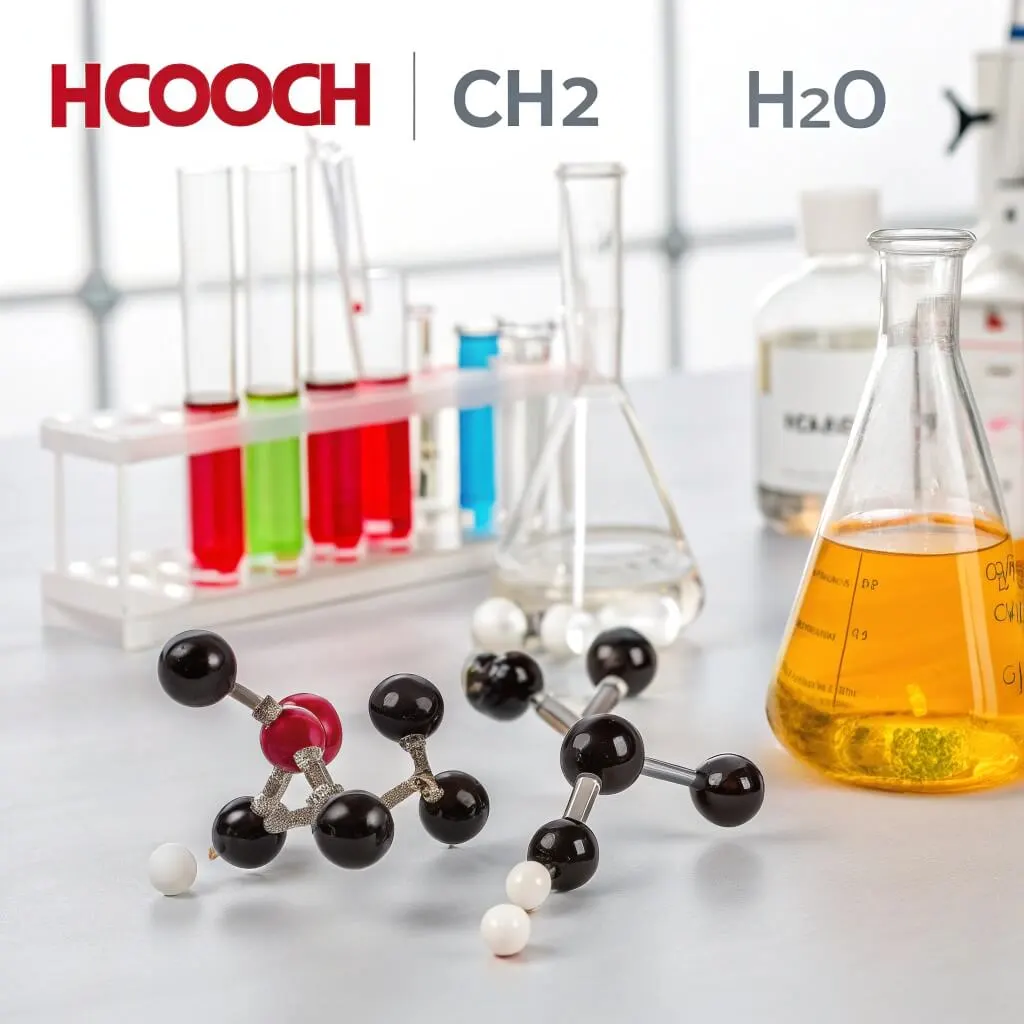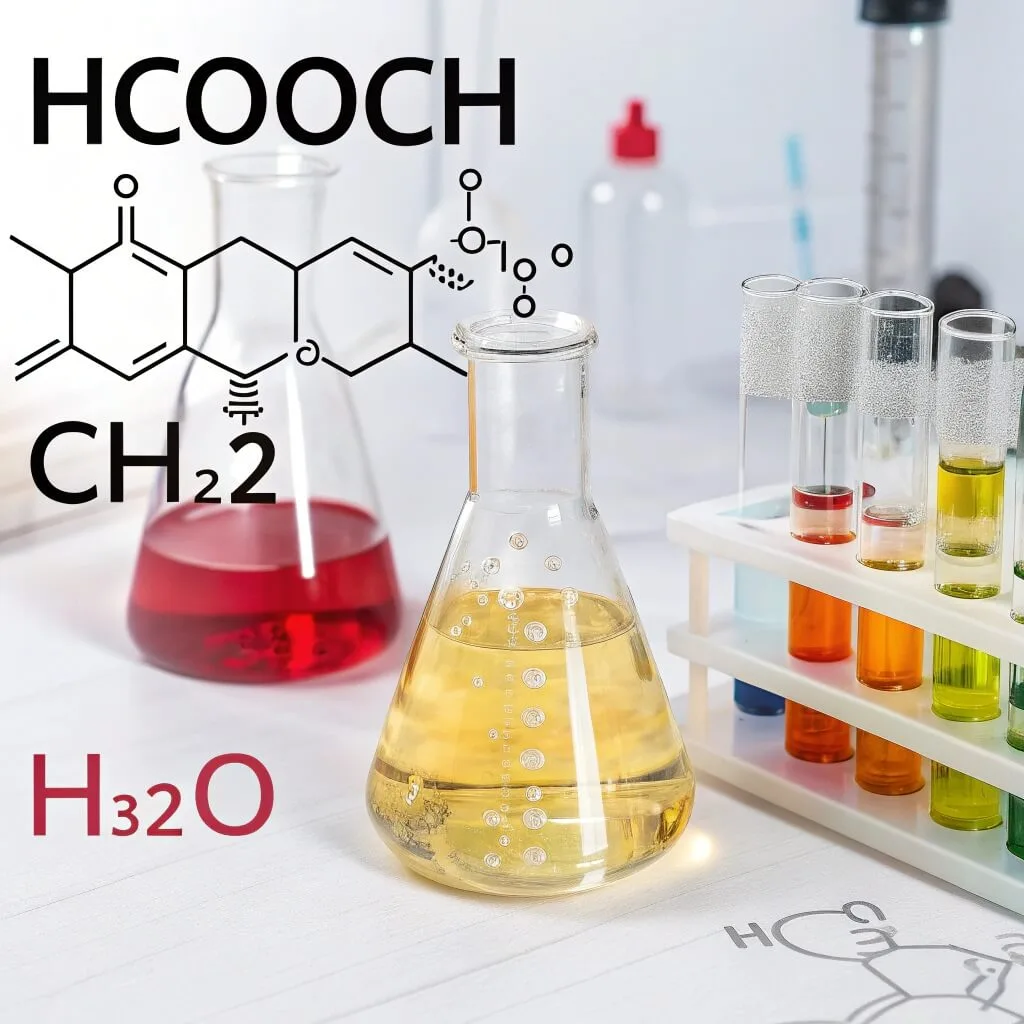In the vast world of chemistry, HCOOCH CH2 H2O represent three fundamental compounds that showcase unique characteristics, reactivity, and vast applications. These compounds – formic acid, methylene, and water – are involved in various natural processes and industrial applications.
From supporting life to facilitating complex chemical reactions, the interplay between HCOOCH, CH2, and H2O is crucial to both organic and inorganic chemistry. This article aims to explore the properties, reactions, and practical uses of these compounds, emphasizing their importance in the chemical world.
What is HCOOCH CH2 H2O?
HCOOCH CH2 H2O represent three distinct chemical entities with significant roles in chemistry. HCOOCH, known as formic acid, is the simplest carboxylic acid with a molecular formula of HCOOH, commonly used in chemical synthesis and as a preservative in agriculture. It has reducing properties and participates in esterification and decarboxylation reactions. CH2, or methylene, is a highly reactive intermediate compound, often found as a carbene (CH2) in organic chemistry.
Methylene plays a crucial role in forming new carbon-carbon bonds in synthetic chemistry, especially in polymerization and cyclopropanation reactions. H2O, water, is an essential molecule in life and chemistry, serving as a solvent in various reactions, and participating in hydrolysis, acid-base equilibria, and redox processes. Together, HCOOCH, CH2, and H2O contribute significantly to chemical reactions, industrial applications, and biological processes.
Unveiling the Role of HCOOCH: Formic Acid’s Unique Chemistry
HCOOCH represents formic acid, a simple yet incredibly versatile compound that plays a significant role in numerous chemical processes. Known for its acidic properties and reducing abilities, formic acid (HCOOCH) is frequently used in both laboratory and industrial settings.
Characteristics of HCOOCH (Formic Acid)
Formic acid, or HCOOCH, is the simplest carboxylic acid, consisting of a single carbon atom attached to a carboxyl group (-COOH), a hydrogen atom, and a hydroxyl group (-OH). Below are some key attributes of this compound:
- Chemical Formula: HCOOCH (Formic Acid)
- Physical State: It is a colorless liquid that often emits a strong, pungent odor.
- Solubility: Highly soluble in water and various organic solvents.
- Acidity: With a pKa value of 3.75, formic acid is moderately acidic, allowing it to participate in various chemical reactions.
Natural Occurrence and Industrial Production
Formic acid (HCOOCH) can be found in nature, especially in the venom of ants and other insects. Industrially, it is synthesized through the hydrolysis of methyl formate or as a by-product during acetic acid production. The efficient and eco-friendly production methods make formic acid an attractive chemical for green chemistry applications.
Chemical Reactions of HCOOCH (Formic Acid)
Formic acid’s ability to act as both an acid and a reducing agent allows it to participate in a wide range of reactions. Key reactions include:
- Esterification Reactions: When combined with alcohols, formic acid creates esters.
- HCOOCH+ROH→HCOOR+H2O\text{HCOOCH} + \text{ROH} \rightarrow \text{HCOOR} + \text{H}_2\text{O}HCOOCH+ROH→HCOOR+H2O
- Decarboxylation: When heated or catalyzed, formic acid decomposes into carbon monoxide and water.
- HCOOCH→CO+H2O\text{HCOOCH} \rightarrow \text{CO} + \text{H}_2\text{O}HCOOCH→CO+H2O
- Oxidation: Formic acid reacts with oxidizing agents to produce carbon dioxide.
- HCOOCH+[O]→CO2+H2O\text{HCOOCH} + [O] \rightarrow \text{CO}_2 + \text{H}_2\text{O}HCOOCH+[O]→CO2+H2O
These reactions highlight formic acid’s role in organic synthesis and other chemical processes.
The Reactive Nature of CH2 (Methylene) in Chemical Synthesis
CH2, also known as methylene, is a diatomic molecule that plays a vital role in organic chemistry. As a reactive intermediate, methylene participates in the formation of more complex molecules through various chemical reactions.
Chemical Structure and Reactivity of CH2
Methylene consists of one carbon atom bonded to two hydrogen atoms, with a significant electron deficiency that makes it highly reactive. Methylene typically exists as carbene (CH2), an unstable intermediate species.
- Chemical Formula: CH2
- Reactivity: Methylene’s electron-deficient nature makes it highly electrophilic and prone to reacting with a wide range of molecules.
Reactions Involving CH2
The high reactivity of CH2 makes it an essential intermediate in many organic reactions:
- Cyclopropanation Reactions: Methylene reacts with alkenes to form cyclopropane rings.
- CH2+C=C→Cyclopropane\text{CH}_2 + \text{C=C} \rightarrow \text{Cyclopropane}CH2+C=C→Cyclopropane
- Bond Formation: Methylene can insert itself into existing carbon-carbon or carbon-hydrogen bonds, leading to the formation of complex molecules in synthetic chemistry.
These reactions demonstrate methylene’s significance in organic synthesis, polymerization, and pharmaceutical production.
The Essential Role of H2O (Water) in Chemical Processes
Water, or H2O, is one of the most vital compounds on Earth, essential for life and involved in countless chemical reactions. Its role as a solvent, its ability to stabilize ions, and its involvement in acid-base reactions make water indispensable in chemical systems.
Properties of H2O (Water)
Water has unique properties due to its polar nature, which plays a critical role in many biological and chemical processes:
- Molecular Structure: Water consists of two hydrogen atoms bonded to one oxygen atom, forming a bent molecular geometry.
- Solvent: Due to its polarity, water can dissolve a wide range of substances, making it the solvent of choice for many chemical reactions.
- Hydrogen Bonding: Water molecules can form hydrogen bonds with other molecules, contributing to water’s high boiling point, surface tension, and its role in biochemical reactions.
Water’s Involvement in Reactions
Water’s versatility extends to numerous chemical reactions:
- Hydrolysis: Water breaks down compounds by adding a molecule of water.
- RCOOR’+H2O→RCOOH+R’OH\text{RCOOR’} + \text{H}_2\text{O} \rightarrow \text{RCOOH} + \text{R’}\text{OH}RCOOR’+H2O→RCOOH+R’OH
- Acid-Base Reactions: Water can act as both an acid and a base in chemical equilibria.
- H2O+H+→H3O+\text{H}_2\text{O} + \text{H}^+ \rightarrow \text{H}_3\text{O}^+H2O+H+→H3O+
- H2O+OH−→2H2O\text{H}_2\text{O} + \text{OH}^- \rightarrow 2\text{H}_2\text{O}H2O+OH−→2H2O
The Role of Water in Redox Reactions
Water is crucial in redox reactions, where it can either donate or accept electrons, depending on the reaction. This makes water a key player in energy transfer processes and biological systems.
Synergy Between HCOOCH, CH2, and H2O in Chemical Reactions
The interaction between HCOOCH, CH2, and H2O can lead to fascinating chemical transformations. For example, formic acid (HCOOCH) can act as a proton donor in reactions involving methylene, helping to stabilize intermediates and facilitating new bond formation. Water often serves as a solvent in these reactions, providing the necessary medium for effective molecular collisions.
Reactions Involving HCOOCH, CH2, and H2O
In some reactions, HCOOCH and CH2 combine to form more complex organic molecules, with water either participating as a reactant or being released as a by-product. The presence of water can influence the reaction kinetics and thermodynamics, allowing for better control over the process.
Practical Uses of HCOOCH, CH2, and H2O in Industry
Formic Acid (HCOOCH) in Industry
Formic acid has diverse applications in several industries:
- Agriculture: Used as a preservative and antibacterial agent in animal feed.
- Textile Industry: Acts as a dye-fixing agent.
- Chemical Synthesis: Formic acid is involved in the production of formate salts, plastics, and other chemicals.
Methylene (CH2) in Chemical Synthesis
Methylene plays a critical role in the creation of complex molecules:
- Polymerization: Methylene is key in the production of polyethylene and other polymers.
- Pharmaceuticals: Used in drug synthesis by enabling the formation of new carbon-carbon bonds.
Water (H2O) in Industrial and Biological Processes
Water is indispensable in a wide array of applications:
- Chemical Manufacturing: Water is essential in many chemical synthesis processes.
- Agriculture: Used for irrigation, supporting crop growth.
- Energy: Water is crucial in cooling systems and energy production, especially in power plants.
Frequently Asked Questions (FAQs) on HCOOCH CH2 H2O
What is the primary use of formic acid (HCOOCH)?
Formic acid is primarily used as a preservative in agriculture, a dye-fixing agent in textiles, and in chemical synthesis processes.
How does methylene (CH2) react in organic chemistry?
Methylene is highly reactive and participates in cyclopropanation, bond formation, and polymerization reactions.
Why is water (H2O) important in chemical reactions?
Water acts as a solvent, facilitates acid-base reactions, and plays a key role in hydrolysis and redox processes.
What are the risks of handling formic acid (HCOOCH)?
While formic acid is relatively low in toxicity, it should be handled with care, as it can be irritating to skin and eyes.
What is the function of water in biological systems?
Water is essential for life, providing a medium for biochemical reactions, nutrient transport, and hydration.
Can methylene (CH2) exist in its pure form?
Methylene is highly reactive and rarely exists in its pure form. It is usually generated in situ during chemical reactions.
How does water (H2O) stabilize ions in reactions?
Water stabilizes ions through hydrogen bonding and solvation, helping to control the progress of chemical reactions.
What are the applications of formic acid (HCOOCH) in agriculture?
Formic acid is used as an antibacterial agent and preservative in animal feed, contributing to the health of livestock.
How does methylene (CH2) contribute to drug development?
Methylene’s ability to form new bonds is crucial in synthesizing complex drug molecules, enhancing pharmaceutical development.
What is the significance of water (H2O) in energy production?
Water is crucial in energy production, particularly in cooling systems in power plants and in the operation of steam turbines.

Conclusion
The study of HCOOCH, CH2, and H2O highlights the essential roles these compounds play in chemistry, industry, business and life itself. Formic acid (HCOOCH), with its reducing and acidic properties, methylene (CH2), with its high reactivity, and water (H2O), with its unparalleled ability to support chemical reactions, interact in diverse ways to facilitate numerous processes.
Understanding these compounds and their interactions enhances our comprehension of both natural phenomena and industrial applications, making them invaluable in the world of chemistry and beyond.

